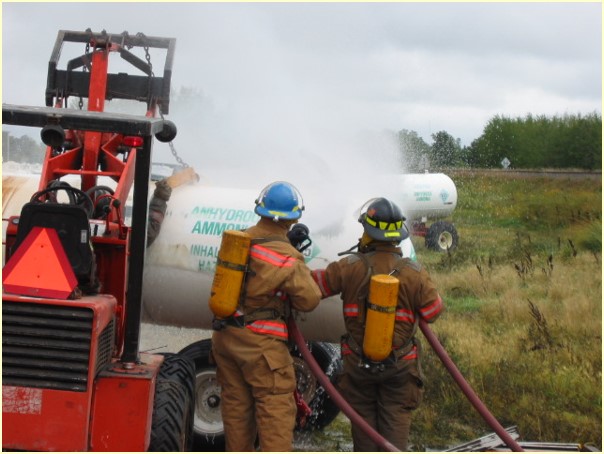
If you respond to, prepare for, or will be in charge when a spill of anhydrous ammonia occurs, you can use the information contained on this page for an effective response. Information on this site is geared toward providing in-depth instruction for our first responders, the fire departments of Minnesota.
Anhydrous ammonia is used as a fertilizer by field corn and wheat growers. Anhydrous ammonia (or just called ammonia) provides nitrogen, an essential plant nutrient to maximize yields. Ammonia is also found naturally in the environment, the result of vegetation and animal waste decay.
Fertilizer ammonia is transported from the site of production via barge, pipeline, rail, and truck to fertilizer terminals or directly to dealers. To conserve space and make it easy to handle, ammonia is kept as a liquid under pressure in specially designed bulk tanks. The fertilizer dealer pumps liquid ammonia from their bulk tank into smaller mobile nurse tanks (illustration of common transfer setup). These nurse tanks are towed to a field and hitched up behind a tractor with a tool bar equipped with knives that inject the liquid ammonia into the soil. Once in the soil, ammonia will quickly react with soil moisture and change to a form the crop can use.
Ammonia was initially used to produce explosives. After World War I ammonia was used as a fertilizer and in the manufacture of numerous other chemicals. It is also very commonly used as a refrigerant, often for food processing and cold storage facilities. Anhydrous ammonia has also been used of late as a precursor in the illegal production of the highly addictive drug, methamphetamine. Although it has many uses and the MDA is only responsible for it when used as an agricultural chemical, much of the response information here does carry over to those other uses.
Ammonia is commercially produced by the reaction of nitrogen from the air and hydrogen gas (from the methane found in natural gas) under high temperature and pressure. This process excludes water thus the term "anhydrous." Fritz Haber of Germany was the first to successfully produce ammonia for which he received the Nobel Prize in Chemistry. Later Carl Bosch refined the process which lead to the first commercial production plant in 1913.
- Identity Information: Learn general chemical information and human exposure limits
- Physical & Chemical Properties: Chemical properties under pressure
- Stability & Reactivity: Ammonia is stable but very reactive
- Exposure Controls and Personal Protection: Protect yourself and others from ammonia exposure
- Fire Department Response: Planning for and responding to ammonia incidents
- First Aid Information: Anhydrous ammonia exposures can be very serious and possibly life-threatening
- Nurse Tank Anatomy: Knowledge of the tank setup enables responders to control tank releases quickly
- Ammonia Incident Summaries: By learning from others’ experiences, your responses will improve and the public will benefit
- Anhydrous Ammonia Theft: Anhydrous ammonia is a key ingredient in the illegal production of methamphetamines (meth)
- Disposal Options: Water used to knock down an ammonia cloud can contaminate nearby water and soil
- Ecological Effects of Spills: Even at extremely low concentrations aquatic life will be harmed by ammonia.

